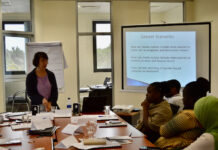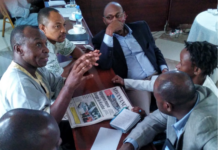
This training module was written as part of a course delivered in Africa to a group of journalists who wanted to learn more about creating in-depth news reports.
Exploring new angles in a news story
Seeking out new angles on a breaking, developing or running news story is an important part of the editorial process.
Journalists have a responsibility to think through and explain how news developments affect the lives of their audience.
This process often takes place in news meetings where editorial staff discuss the implications of events in order to decide which deserve further investigation.
However, a journalist working alone will often have to work out the most important angles for themselves.
How a story develops
News stories break in many ways. Sometimes the first we hear of a story is on the news wires.
At other times a journalist will have been digging around a topic and will have come up with information that deserves further investigation.
At this stage, often all we have are one or two facts. Our job is to find out more. As we do, the story develops.
Eventually, we would hope to publish or broadcast a comprehensive and informative report with all angles covered. So, let’s take an actual story and see how this works.
Researching behind the headlines
On January 12, 2012, a story was running on BBC News Online’s Africa section.
Let’s imagine we are in a news meeting on that day, discussing how to move this story forward. What questions would we ask?
Let’s look at the story, Kampala shops shut over Uganda interest rates.
The story reads: “Businesses in Uganda’s capital, Kampala, have closed their shops and are boycotting banks to protest at high interest rates.”
Possible angles:
- Which businesses?
- We need to talk to a few and find out how much they are likely to lose through the protest.
- How long can they continue without the banks?
- What are the alternatives?
- We need to know who their customers are and what they are going to do now the shops are closed.
The story reads: “A BBC correspondent says most shops are closed, leaving customers who travel to Kampala from across east Africa unable to stock up. Kampala is an east African trading hub and many of the people unable to shop have come from other parts of Uganda, as well as eastern Democratic Republic of Congo and South Sudan.”
Possible angles:
- How do they get to Kampala?
- What are these goods that they are unable to buy?
- How are these goods usually transported back to the other areas of east Africa?
- What about those who make a living from transporting these people and goods?
- What are they going to do now? Can they survive?
- What are the implications for locals? How are they coping without supplies?
The story reads: “Business owners also say for the next three days they will withdraw all their savings from commercial banks and stop making any deposits into their accounts.”
Possible angles:
- Where will they put their savings now?
- Are there alternative safe places to deposit money?
- What are these alternatives and how easy is it to transfer funds?
- What is the possible long-term implication for businesses, the customers and the country’s economy?
- Why are interest rates so high?
- And how high are they and relative to what?
The story reads: “City traders have used this tactic before, in July last year, to protest over the country’s weakened currency and the presence of cheap goods in Chinese shops.”
Possible angles:
- What happened last July?
- Have we any archived material?
- Want promises and predictions were made then?
- How long did that action last?
- What were the implications?
- Can we do a compare and contrast of then and now?
Angles enrich news stories
So, from taking a fairly basic story we could develop more than a dozen related stories, each exploring the significance of elements in the original story in a way that could help the audience understand the possible impact of what is happening around them.
And as we explore the related stories, more story angles will come to mind.
Try it for yourself
Exercise: Break into groups of three, examine a story currently running on one of the major news sites, and find at least 10 angles which you feel could be explored, explain why they should be explored and set out how you would follow up each of those angles including who you would talk to and what you would ask them.








